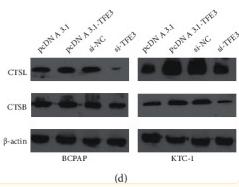Cathepsin L Antibody - #DF12880
| Product: | Cathepsin L Antibody |
| Catalog: | DF12880 |
| Description: | Rabbit polyclonal antibody to Cathepsin L |
| Application: | WB IF/ICC |
| Cited expt.: | WB |
| Reactivity: | Human, Mouse |
| Mol.Wt.: | 25-40kD; 38kD(Calculated). |
| Uniprot: | P07711 |
| RRID: | AB_2845841 |
Related Downloads
Protocols
Product Info
*The optimal dilutions should be determined by the end user. For optimal experimental results, antibody reuse is not recommended.
*Tips:
WB: For western blot detection of denatured protein samples. IHC: For immunohistochemical detection of paraffin sections (IHC-p) or frozen sections (IHC-f) of tissue samples. IF/ICC: For immunofluorescence detection of cell samples. ELISA(peptide): For ELISA detection of antigenic peptide.
Cite Format: Affinity Biosciences Cat# DF12880, RRID:AB_2845841.
Fold/Unfold
Cathepsin L; cathepsin L, 1 b; Cathepsin L1; Cathepsin L1 light chain; CathepsinL; CATL; CATL1_HUMAN; cb15; CTSL; CTSL1; ctsl1b; FLJ31037; hgg1; Major excreted protein; MEP; MGC123162; wu:fb30g09;
Immunogens
A synthesized peptide derived from human Cathepsin L, corresponding to a region within the internal amino acids.
- P07711 CATL1_HUMAN:
- Protein BLAST With
- NCBI/
- ExPASy/
- Uniprot
MNPTLILAAFCLGIASATLTFDHSLEAQWTKWKAMHNRLYGMNEEGWRRAVWEKNMKMIELHNQEYREGKHSFTMAMNAFGDMTSEEFRQVMNGFQNRKPRKGKVFQEPLFYEAPRSVDWREKGYVTPVKNQGQCGSCWAFSATGALEGQMFRKTGRLISLSEQNLVDCSGPQGNEGCNGGLMDYAFQYVQDNGGLDSEESYPYEATEESCKYNPKYSVANDTGFVDIPKQEKALMKAVATVGPISVAIDAGHESFLFYKEGIYFEPDCSSEDMDHGVLVVGYGFESTESDNNKYWLVKNSWGEEWGMGGYVKMAKDRRNHCGIASAASYPTV
Research Backgrounds
Thiol protease important for the overall degradation of proteins in lysosomes (Probable). Involved in the solubilization of cross-linked TG/thyroglobulin and in the subsequent release of thyroid hormone thyroxine (T4) by limited proteolysis of TG/thyroglobulin in the thyroid follicle lumen (By similarity).
Lysosome. Apical cell membrane>Peripheral membrane protein>Extracellular side.
Note: Localizes to the apical membrane of thyroid epithelial cells.
Belongs to the peptidase C1 family.
Research Fields
· Cellular Processes > Transport and catabolism > Autophagy - animal. (View pathway)
· Cellular Processes > Transport and catabolism > Lysosome. (View pathway)
· Cellular Processes > Transport and catabolism > Phagosome. (View pathway)
· Cellular Processes > Cell growth and death > Apoptosis. (View pathway)
· Human Diseases > Cancers: Overview > Proteoglycans in cancer.
· Human Diseases > Immune diseases > Rheumatoid arthritis.
· Organismal Systems > Immune system > Antigen processing and presentation. (View pathway)
References
Application: WB Species: Human Sample: PTC cells
Restrictive clause
Affinity Biosciences tests all products strictly. Citations are provided as a resource for additional applications that have not been validated by Affinity Biosciences. Please choose the appropriate format for each application and consult Materials and Methods sections for additional details about the use of any product in these publications.
For Research Use Only.
Not for use in diagnostic or therapeutic procedures. Not for resale. Not for distribution without written consent. Affinity Biosciences will not be held responsible for patent infringement or other violations that may occur with the use of our products. Affinity Biosciences, Affinity Biosciences Logo and all other trademarks are the property of Affinity Biosciences LTD.



